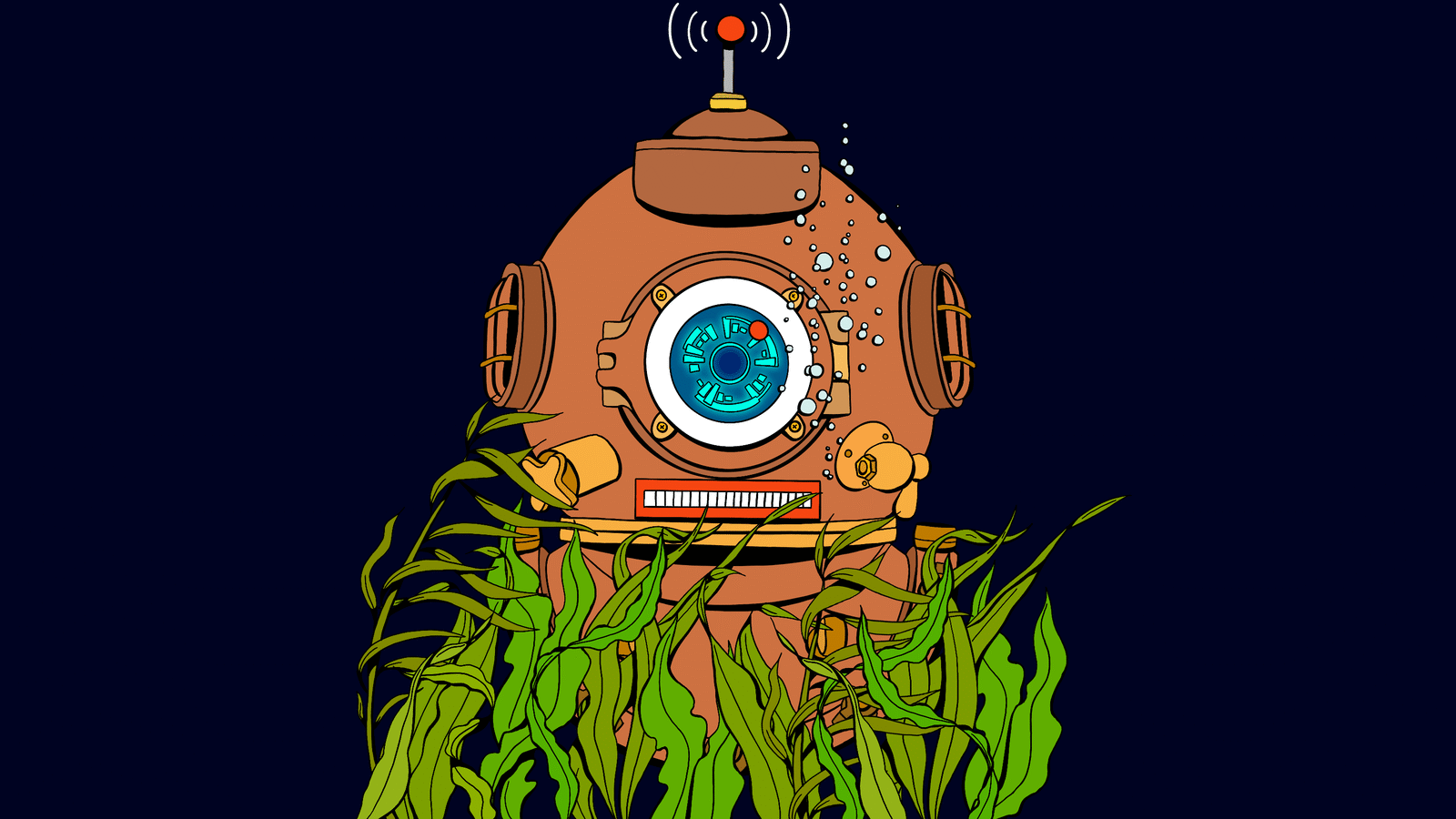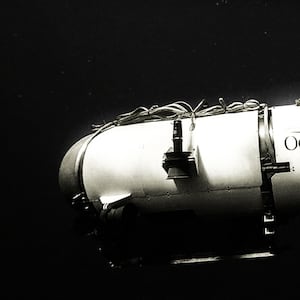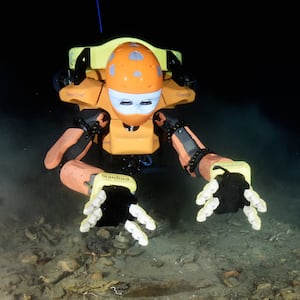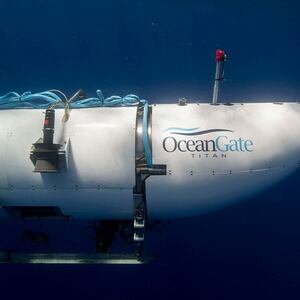Before the doomed crew of OceanGate’s Titan submarine embarked on their fatal expedition to view the deep-sea wreckage of the Titanic, the vessel was hand-ratcheted closed, making it impossible to open from the inside. It is the kind of detail mundane in its disregard for safety best practices—and so haunting that David Szymanski, creator of indie horror submarine exploration game Iron Lung included it in his story specifically because of how nightmarish it was.
In a press conference held the afternoon of June 22, the U.S. Coast Guard, which was involved in the search for the lost vessel, said it believed the vessel had imploded near the wreckage of the Titanic. While the passengers confined inside could not let themselves out, the water of the deep dark sea was more than capable of forcing its way in.
In the days since the Titan went missing on Sunday, and before the discovery of floating debris led the Coast Guard to pronounce it lost on Thursday, many people reflected on how hostile the abyssal depths are to human life. Indeed, the environment is arguably more inhospitable than the vacuum of space—a comparison underscored by the fact that Hamish Harding, one of the OceanGate passengers, had already survived a trip to the edge of space in 2022. In space, pressurized suits and spacecraft outfitted with life support help keep astronauts’ bodies functioning normally. In a submersible, pressurization of the chamber is needed to keep the crushing weight of the ocean out.
For decades, oceanographic exploration required vessels that could keep humans safe inside, while allowing them to operate machinery and record their surroundings. OceanGate’s late CEO Stockton Rush, who died piloting the Titan, went on the record repeatedly boasting that his company had purposefully skirted safety regulations while building a vessel which could still reliably explore the depths and return to the surface, passengers intact. Which Titan did, until it abruptly didn’t.
A 2019 OceanGate blog post emphasized that, though the Titan was not classed by an independent group that rates ships for safety, that was fine because classing protocols “do not ensure that operators adhere to proper operating procedures and decision-making processes—two areas that are much more important for mitigating risks at sea.”
It is at this point impossible to know if the vessel failed for mechanical, structural, or operator error. Perhaps further salvage will reveal the exact nature of the fatal accident, or maybe the surviving family of those lost can extract such answers through depositions in court. Whatever the cause of Titan’s failure, human-crewed submersibles for deep-sea exploration do not, inherently, need to be built in such a manner.
Blockbuster filmmaker James Cameron, who directed the 1999 mega-hit Titanic and is a self-declared member of “the deep submergence engineering community” James Cameron told ABC News “deep submergence diving is a mature art,” emphasizing that it can be done safely if done with care, caution, and rigorous testing, as it generally has been for decades.
Rush pitched OceanGate on deep-sea tourism, with the Titanic wreck as its primary draw. While the site is hard to access, it was first discovered with towed underwater sensors in 1985 and first explored by a human-crewed vessel, Alvin, in 1986. As a sign of the seriousness with which most human-crewed submersibles are treated, Alvin’s latest upgrades began in 2011 and were finished in 2021. By contrast, construction on Titan began in 2013, with its first crewed expedition underway in July 2021. That’s a startup pace for moving fast and breaking things, and few things move faster or break things more effectively than deep water rushing into a depressurized cabin.
Titan and OceanGate is a cautionary tale in many respects, even if the cautions like ‘ensure the vessel has a locator beacon for when it gets lost’ seem glaringly obvious. It should also suggest that, just like extraorbital exploration in space, humans can get better results, with lower risk to life and limb, by sending robots into hostile environments instead of humans.
If the safety of passengers feels secondary to proving that a cheaper vessel could reach the depths, it plausibly is. The Associated Press reports that for Rush, “Part of the idea behind OceanGate was to offset the cost of deep-sea research through high-end adventure tourism, exploration or mapping for the oil and gas industry, or inspection of bridges or ship hulls.”
Wrapping the submersible in the name of exploration and tourism may have been a way to attract investors, but if the ultimate goal was to produce a cheaper deep-sea submarine that could meet both commercial and scientific exploratory missions, Rush would have been better off working on uncrewed underwater robots.
Including a human operator in a vessel makes it easier to control—so easy that it can be done with a video game controller (though Rush’s preference for a wireless bluetooth controller over a wired controller was an especially odd choice). When it comes to uncrewed vessels, there are essentially two modes of operation. The first is a remotely operated vehicle, which is a tethered undersea robot that communicates with either a surface ship or a human-crewed submarine through a cable. Such a machine can even be steered by a video game-style controller. That can ensure continuous communication and high-bandwidth flow of information, but it limits the distance at which the robot can operate removed from its mothership.
The other way to have a robot underwater is to build it around some degree of autonomous operation.
Autonomous underwater robots already exist, like the torpedo-shaped Slocum gliders used by the Naval Oceanographic Office to record water conditions across the globe. A whole new ecology of underwater military robots exist, fielded or in development, with missions like benign oceanographic sensing or tracking other underwater submarines. Communication with such vessels can suffer the same obstacles as communicating from the surface with crewed submarines. Some tools, like very low frequency radio waves used to communicate to nuclear submarines, require vessels to be in shallow depths, 30 meters or so, to work.
Acoustic communications can transmit low-bandwidth signals while underwater, allowing for some degree of communication between an autonomous vessel and humans monitoring it, but most of the data transfers will be done when these submarines surface to transmit it, or can offload it by physical connection to a friendly vessel.
Relying on autonomous systems for underwater exploration is, by default, a hands-off approach. It requires careful design and a degree of trust that the machine, once sent on its mission, can stay in communication, and transmit useful information. Developing these systems will likely result in some robotic submarines being lost along the way. When that happens, the worst result is a setback in research, and possibly a failure to transmit data collected by the robot.
What will not happen, when sending a robot explorer to chart new depths, is a tragic loss of life. There are no life support systems on robots that can fail, and there’s no nervous human occupant to experience the stress of being bolted into what they can only hope is an airtight capsule.
Titan’s fall will likely not spell the end of deep-sea exploration by crewed vessels, though it should prompt caution among underwater expeditions and a renewed sense of self-preservation among any future underwater tourists. But for companies whose ultimate aim is to send sensors to the deep, whatever their motive, it’s work best entrusted to the unblinking mechanical eyes of robots. Leaving most exploration to machine autonomy acknowledges the limits of human ability, and it will take time to perfect. Still, after this week, better to sink slowly, rather than rush to the bottom.










